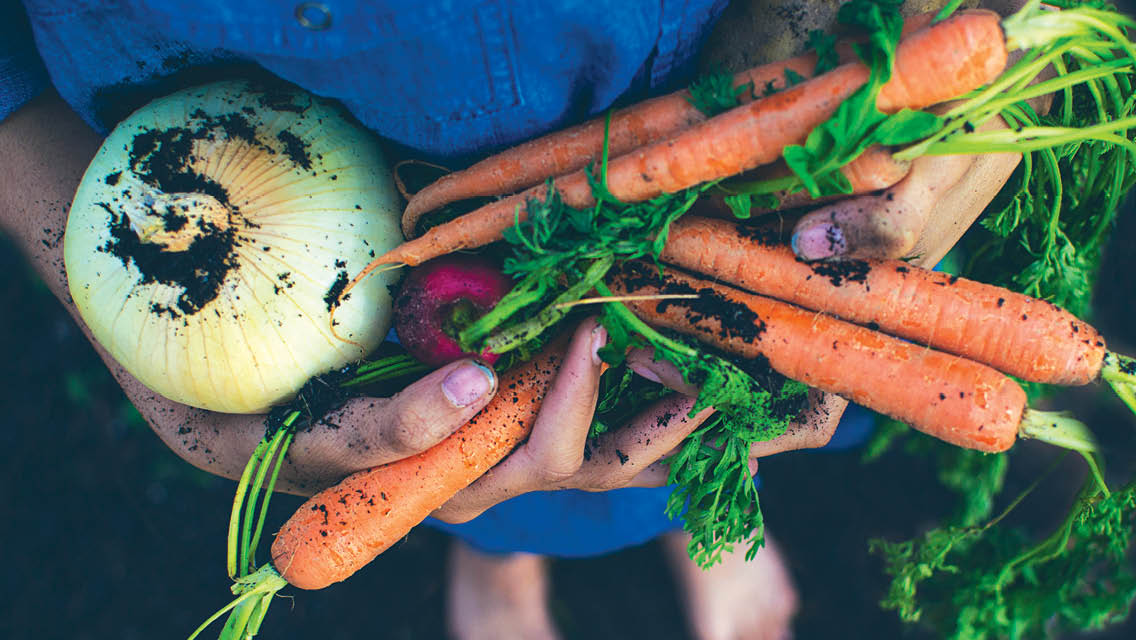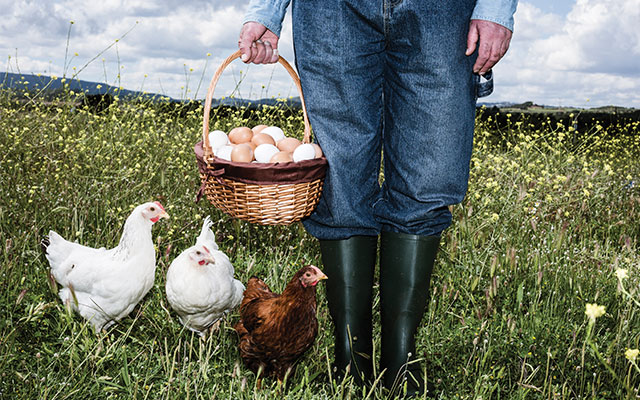What we eat affects our health. This we know. But it also affects the health of the whole planet, and it may be truer now than at any time in history: Food production is linked to climate change, and climate change is influencing food production.
Evolving weather patterns that feature longer droughts and more intense rains now disrupt traditional growing seasons. As it becomes more difficult for farmers to harvest normal crop yields, large-scale commercial producers use more water, fertilizer, herbicides, and pesticides — all of which take a heavy toll on ecosystems.
Meanwhile, food packaging creates a massive stream of nonbiodegradable waste, and shipping food around the globe burns oil, creates emissions, and increases carbon in the atmosphere.
A recent study of worldwide vegetable production found that if the output of greenhouse gases continues to grow at its current rate, harvest yields could drop 35 percent within the next 80 years, largely because of water shortages. In that same time frame, the world population is expected to reach at least 10 billion — and an overstressed climate is going to make it harder to meet our collective food needs.
What can we possibly do to counter climate change?
Plenty. And much of it starts with our food choices.
“The message that you send with what you buy and eat is much greater than you think,” says Walter Baethgen, PhD, senior research scientist at the International Research Institute for Climate and Society at Columbia University. “Individual choices do make a difference. It’s like voting — every vote counts, and every food purchase you make counts, too.”
As the rapid growth of the organic-food industry shows, consumer choices can affect how food producers manage the land. Making small dietary changes that support sustainable farming practices can offset climate change. The following steps toward climate-friendly eating can also help.
1. Eat More Plants
A sweeping 2018 study published in Science consolidated data on the environmental impact of some 38,000 farms around the world. One key finding: A plant-based diet can yield substantial environmental benefits.
Though the climate-friendly effects of eating more plants has been supported by earlier research, study coauthor Joseph Poore, an Oxford University environmental analyst, notes that this study is the first to show that plant-based diets are much easier on ecosystems than the production of most animal foods.
Meat, aquaculture, eggs, and dairy use about 83 percent of the world’s farmland, Poore explains — and they contribute nearly 60 percent of the planet’s greenhouse-gas emissions. Yet these foods provide only 18 percent of the calories we consume. This is why many climate-conscious eaters believe that eliminating meat and dairy altogether is key to environmental sustainability.
Still, strict adherence to a plant-based diet isn’t practical for many of us — something food writer and cookbook author Mark Bittman admits. He’s found a middle way, avoiding animal products at breakfast and lunch, then eating whatever he likes for dinner. He terms this a “mostly vegan” diet.
In a 2013 New York Times column, he wrote: “To the often-asked question ‘How will we feed the 9 billion?’ — used to defend a host of objectionable agricultural practices — many of us say, ‘Focus more on feeding people plants and less on feeding them animals.’”
In another large 2018 study published in Nature, an international team of researchers called for a global shift to a more plant-based diet, recommending that wealthier Western countries reduce meat consumption by 90 percent and milk consumption by 60 percent, while eating five times more legumes. This shift is necessary, they argue, to keep global temperatures from rising more than 1.5 degrees Celsius — a threshold set by the 2018 United Nations report on climate change.
If you adopt these suggestions, it could mean eating meat every 10th meal and getting protein from legumes and nuts in the other nine. You could also try swapping half your dairy choices for plant-based alternatives.
2. Support Small Farms
Small farms are more climate friendly than mega-monoculture operations. More-diverse crops help build topsoil, and it’s easier to manage pests and weeds without chemicals on a human-scale farm.
But small-scale farming is risky. Farmers don’t control the weather, yet weather controls their livelihood. And because federal subsidies strongly favor agribusiness, small, diverse, organic farms get little help if their crops don’t get watered — or get washed away.
You can support some of these small farmers by buying a “share” of their crop before planting starts. The community-supported agriculture (CSA) model helps farmers raise seed money — sometimes literally, so they can buy seeds — and plan for a growing season with more predictability than relying solely on potential sales at farmers’ markets.
By purchasing a percentage of the season’s yield, you share some of farming’s inherent risk and support the farmer’s ability to employ more sustainable methods and grow more-diverse crops. CSA farms often raise a wide variety of vegetables, along with some fruits; members receive some of the harvest each week.
As you forge a connection with a particular farm and its stewards, you’ll learn about its growing practices. Not all climate-friendly farmers are certified organic: Certification can be costly, laborious, and intrusive. But that doesn’t mean the food they grow isn’t chemical-free, says Kristin Ohlson, author of The Soil Will Save Us: How Scientists, Farmers, and Foodies Are Healing the Soil to Save the Planet.
“As the organic designation became codified, there was some rigidity in terms of farming practices,” she notes. “Not all farmers want to fit into that.”
Whether a CSA farm is certified organic or not, its growing practices are probably transparent enough that you can determine whether they nourish the land — which means the produce will nourish you, too.
3. Shop Farmers’ Markets
Buying produce at farmers’ markets isn’t as convenient as shopping at grocery stores. Markets are seasonal, they’re open for limited hours — often in the morning — and they won’t offer every vegetable and fruit under the sun. Yet the effort to buy more of your food directly from farmers produces a substantial ripple effect.
Consider these climate-friendly reasons for getting up early on market day:
- You can speak to farmers directly about their growing practices and animal welfare.
- You know the food wasn’t trucked in across the country — or sent via ship or airplane from around the globe — which cuts down on transportation costs and fuel use.
- The food is rarely packaged, so there’s little waste, especially if you bring your own reusable bags.
“Add up your food dollars at the end of the week,” advises Joel Salatin, who owns Polyface Farm, a “beyond-organic” pasture-based farming operation in Virginia. “How much went toward supporting a system that helps the environment, and how much went toward hurting it?”
With farmers’ markets and CSA shares, you forge connections to sustainable growing practices, Salatin says. Aim to buy most of your food directly from farmers, he suggests, rather than simply augmenting grocery-store purchases.
4. Avoid Feedlot Meat
Meat consumption is a thorny climate issue. Meat is a resource-intensive food, requiring a lot of water and land, so doesn’t it make sense to eliminate it? Yet Salatin and other food activists argue that this is the wrong question. In their view, it’s more useful to ask, “How was this meat raised?”
“It’s not beef that’s the problem,” Salatin says. “It’s the production model.” He notes that people often point to methane emissions from ruminants like cattle as reasons to not raise them. Methane — like carbon dioxide — is a greenhouse gas, and it gets trapped in the atmosphere, warming the planet.
Yet cattle feeding on grassy pastures as opposed to dirt-packed feedlots not only produce far less methane, Salatin says, but they also contribute to soil bacteria that actually capture some methane from the atmosphere.
Grass-finished beef does require more land than feedlot beef, but it uses less water. And the manure in the pastures helps rebuild topsoil, a carbon-sequestering resource that’s fast disappearing.
Much like buying vegetables and fruits from farmers focused on sustainable practices, carefully sourcing meat is a small but essential step toward reinforcing the market for humanely raised animals and encouraging farmers to reconsider the efficacy of feedlot systems, says Josh Tickell, author of Kiss the Ground: How the Food You Eat Can Reverse Climate Change, Heal Your Body and Ultimately Save Our World.
“If you’re not eating meat because of an ethical or moral stance, I respect that,” he says. “But if you’re avoiding it to be environmentally conscious, it’s more effective to reward the producers who are doing it right.” (For more on selecting sustainable meat, read “The Conscientious Carnivore.”)
5. Select Sustainably Raised Fish
At first glance, it might seem that fish is a more sustainable choice than land animals, but Tickell says the issue is complicated. Given the perilous state of our oceans, he believes we may be past the point where wild fish can be sustainably harvested.
“Ocean pollution has caused massive die-offs of fish and ocean plant life, and we have a very, very long way to go to get back to clean and safe seas,” he says. “It’s not lost forever — we can undo the damage — but in the meantime, we need to look at sustainable fish-farming operations.”
Much like he recommends choosing meat producers who are employing eco-friendly strategies, Tickell suggests researching your fish choices. The Monterey Bay Aquarium’s Seafood Watch (www.seafoodwatch.org), available both online and in a wallet-size print version, is a comprehensive guide for determining which fish are safest to consume and which are best avoided, whether because of toxins or overfishing. Use the app when you’re dining out; it allows you to look up whatever fish is on the menu. (Read more on selecting sustainable fish at “How to Choose Seafood That’s Nutritious, Sustainable — and Safe.”)
6. Waste Less Food
This one is simple: To support the planet, eat more of your food. Americans discard more than a quarter of the food they buy, and food waste in landfills is a major contributor to methane emissions. Not only that, the water and other resources involved in food production are likewise wasted.
Buy perishables in smaller amounts so you can eat them all before they go bad. Stick to your grocery list. Use a compost bin to turn your scraps into soil in your garden. (For more ideas on reducing your food-waste footprint, see “How to Reduce Your Food-Waste Footprint.”)
7. Increase Your Food Budget
Good-quality food from small producers often costs more. But think of it as paying upfront to avoid the hidden health costs — personal and planetary — of poor-quality fare.
Demand, meanwhile, may help reduce those prices over time. As more people start to read labels — or opt instead for whole food without labels — some producers are beginning to tout practices like lower water usage and humane animal treatment as competitive advantages, says Baethgen.
Consumer interest in safety and sustainability is changing the food industry, too: Demand for non-GMO foods, for example, increased 426 percent between 2010 and 2014, according to a Whole Foods Market study.
Americans have developed somewhat distorted ideas of what food really costs to produce. Big-box grocery prices can be deceptively cheap thanks to outdated government subsidies for storage crops. This makes it hard to swallow the $20 price tag the first time you purchase a whole, pasture-raised chicken at the farmers’ market.
Still, if you’re making food choices with the climate in mind, you’ll be eating less meat anyway. And when you pay this much for a bird, you’re more likely to use and enjoy all of it — eating every ounce of meat and making stock with the bones.
When the price gets to you, Salatin suggests thinking of the additional cost as a downpayment on the future. “If you pay an extra $1,000 a year for food that supports a farmer who is trying to change the ecology of our landscape, it can help ensure a place for our grandchildren to inherit.” (For more on saving money on organics, read “8 Ways to Save Money on Organic Groceries.”)
8. Buy in Bulk
Purchasing food in bulk is a great way to economize while also minimizing the amount of packaging destined for the landfill. Here are some ideas to try:
- Buy half a side of beef or a whole pig directly from a farmer (or sustainable butcher), butchered into its usable parts, and store it in your freezer. Split this with another family if it feels like too much meat for one season. You’ll know exactly where the animal came from, and it will dramatically lower your cost. (Visit www.eatwild.com to find pasture-based livestock farmers in your area.)
- Bulk-buy storage-ready produce, such as beets, squash, potatoes, onions, and garlic.
- Keep a good variety of legumes on hand, especially quick-cooking varieties like red lentils. Make big batches and freeze them in portions.
9. Cook From Scratch
Climate-conscious eating requires more food preparation. This can make busy people sigh in protest, but the positive ripple effects of scratch cooking cannot be denied.
“Processed food is energetically very expensive when it comes to environmental impacts,” explains Richard Manning, author of Against the Grain: How Agriculture Has Hijacked Civilization. All the elements of processing — manufacturing, packaging, transportation, and waste management — involve water, electricity, and fuel every step of the way.
Sidestepping processed food in favor of home cooking helps you forge a closer connection to what you’re eating, he adds. And when we cook, we tend to diversify our meals. The availability of fresh foods changes with the season and we adapt. (For more on eating with the seasons, read “The Case for Seasonal Eating.”)
This is not only great for our personal health, because we get more-diverse micronutrients, but it’s also a big win for soil health. The more types of plants that farmers can grow and sell, the better for the soil. Each plant brings unique, beneficial components that foster topsoil nutrition.
10. Seek Progress, Not Perfection
The relationship between climate change and food production is complicated, so when you start to make changes, keep it simple.
Even Salatin, who has built his life around sustainable agriculture, cautions people against obsessing about perfection. Small changes add up, he believes. Maybe today you go to the farmers’ market. You start perfecting your meal-prep wizardry and increase the frequency of plant-based meals. Next week, you research a few local farms that are offering humanely raised pigs; this summer, you sign up with a CSA. Eventually, you ditch most packaged food, but you don’t beat yourself up about it when you can’t.
“I’m a big fan of the 80/20 rule,” says Salatin. “If 20 percent of your food isn’t the ‘good kind,’ then that’s OK. Aim for 80 percent for a climate-friendly diet to take the pressure off.”
This originally appeared as “Take a Bite Out of Climate Change” in the April 2019 print issue of Experience Life.




This Post Has 0 Comments